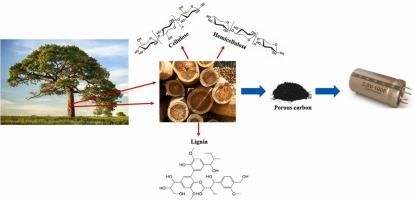Challenges and prospects of synthesizing biomass-derived porous carbon for electrochemical capacitors
引用次数: 0
Abstract
The rising global demand for energy, driven by industrial growth and urbanization, has intensified reliance on fossil fuels, leading to environmental issues such as resource depletion and greenhouse gas emissions. In response, renewable energy sources such as wind and solar are becoming more prominent, but their intermittent availability necessitates the advancement of efficient energy storage solutions. Electrochemical energy storage systems, particularly electrochemical capacitors (ECs), are ideal for applications in electric vehicles, grid stabilization, and portable electronics. However, their low energy density compared to batteries remains a critical challenge, highlighting the need to explore advanced electrode materials to enhance performance. Among various materials, biomass-derived porous carbon (BDPC) has attracted considerable attention due to its abundant availability, environmental sustainability, high surface area, and adjustable porosity. BDPC, sourced from renewable precursors such as lignin, cellulose, and wood sawdust, exhibits unique structural characteristics that greatly influence its electrochemical performance. The choice of biomass precursor is crucial in determining key properties such as pore size distribution, surface area, and conductivity, all of which directly impact capacitance and overall efficiency of ECs. Despite its potential, BDPC faces several challenges in large-scale production, cost-effectiveness, and maintaining consistent material properties during manufacturing. Optimizing synthesis methods and activation strategies is crucial for enhancing BDPC's energy storage capabilities and advancing its transition from laboratory research to commercial use. This review examines the diverse applications of BDPC in ECs and evaluates its potential for large-scale commercialization. It explores key opportunities and barriers related to performance optimization, market feasibility, and regulatory compliance. Additionally, recent advancements in BDPC materials are discussed, with a focus on their structural characteristics, electrochemical properties, and strategies to enhance their energy storage performance. By analyzing current trends and emerging opportunities, this review provides valuable insights into how BDPC can contribute to increasing demand for high-performance, sustainable energy storage solutions.

制备电化学电容器用生物质多孔碳的挑战与展望
在工业发展和城市化的推动下,全球能源需求不断上升,加剧了对化石燃料的依赖,导致了资源枯竭和温室气体排放等环境问题。因此,风能和太阳能等可再生能源正变得越来越突出,但它们的间歇性可用性需要推进高效的能源存储解决方案。电化学储能系统,特别是电化学电容器(ECs),是电动汽车、电网稳定和便携式电子设备应用的理想选择。然而,与电池相比,它们的低能量密度仍然是一个关键的挑战,突出了探索先进电极材料以提高性能的必要性。在众多材料中,生物质衍生多孔碳(BDPC)因其丰富的可用性、环境可持续性、高表面积和可调节孔隙度而备受关注。BDPC来源于可再生前体,如木质素、纤维素和木屑,其独特的结构特征极大地影响了其电化学性能。生物质前驱体的选择对于决定诸如孔径分布、表面积和电导率等关键性能至关重要,所有这些都直接影响ec的电容和整体效率。尽管具有潜力,但BDPC在大规模生产、成本效益和制造过程中保持材料性能的一致性方面面临着一些挑战。优化合成方法和激活策略对于提高BDPC的储能能力和推进其从实验室研究到商业应用的过渡至关重要。本文综述了BDPC在ECs中的各种应用,并评估了其大规模商业化的潜力。它探讨了与性能优化、市场可行性和法规遵从性相关的关键机会和障碍。此外,还讨论了BDPC材料的最新进展,重点讨论了它们的结构特征、电化学性能以及提高其储能性能的策略。通过分析当前趋势和新兴机会,本综述为BDPC如何促进高性能、可持续能源存储解决方案需求的增长提供了有价值的见解。
本文章由计算机程序翻译,如有差异,请以英文原文为准。
求助全文
约1分钟内获得全文
求助全文

 求助内容:
求助内容: 应助结果提醒方式:
应助结果提醒方式:


